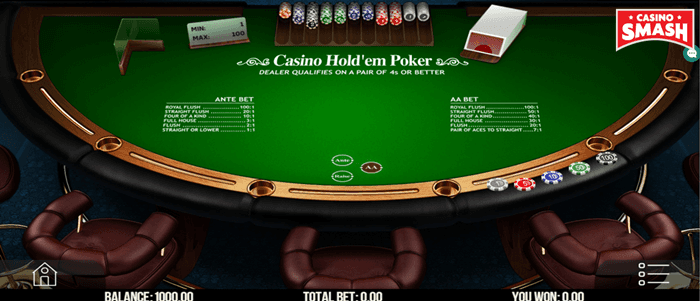Texas Holdem Betting Tips Average ratng: 3,7/5 7412 votes
Good starting hand selection is very important
If you structurally choose to play better hands than your opponents then you will already have a great advantage over them. Especially if you are just starting out in Texas hold'em then good starting hand selection will keep you out of trouble after the flop.
The top ten best Texas hold'em starting hands
1 2 3 4 5 6 7 8 9 10 AA KK QQ JJ AKs AQs TT AKo AJs KQs The little 's' stands for 'suited' and the 'o' for 'unsuited' or 'of suit'. Good starting hands are those hands which either don't need to hit the flop (like big pairs) or often make the best hand when they do hit the flop. These hands make the best possible flushes and make top pairs with very strong second cards ('kickers').
The worst Texas hold'em starting hands
1 2 3 4 5 6 7 8 9 10 72o 82o 73o
83o26 29
39
492To 59o 47
48
58
63Q3o
K2o
J5oA2o
A4o
A6oThe bad starting hands do not offer the possibility to hit a straight or flush with both cards; they are unconnected and unsuited. They will hit low pairs or top pairs with bad kickers and will lose you chips when your opponent hits the same pair with a better kicker. Don't play these hands. They will get you in trouble more often than not.
Keep an eye on your position
If you have the button or are close to the right of the dealer then you will be very likely to act last after the flop. This gives you an informational advantage over your opponents: you can see what they do before you have to act. Try to take advantage of this by playing more hands 'in position' then 'out of position'; play most of your hands when you are (close to the right of) the dealer.
Do not overplay single pair hands
Putting a lot of your chips in the pot with just a single pair rarely is a good idea. If you have a middle pair or a top pair with a weak kicker and are facing strong bets from your opponent then you are usually beat. Fold, keep an eye on this opponent and win your chips back when you are the one with the stronger hand and he or she isn't able to let go of the weaker hand like you did.
Don't slowplay big pairs
Big pairs like aces, kings and queens are great hands to be putting a lot of chips in the pot with unless you see the flop with many opponents. Then the chance of someone hitting a better hand than you will be bigger. Just raise your big pairs pre-flop to fold out the weaker hands that might flop a lucky two pair otherwise and to give yourself a higher chance of winning the hand.
Try to be the aggressor
If you are aggressive, meaning that you bet and raise a lot instead of just calling, then you give your opponent the option to fold to your bets. By taking initiative and being aggressive you therefore give yourself an extra possibility of winning the hand. Don't overdo it though; you don't want to be aggressive with a hand that would deserve a fold instead.
If you're playing the board, your opponent can see your hand
What this means is that if you make a hand with both your hole cards it will be more concealed for your opponents and the chance of your hand being second best is generally smaller. Don't draw to a one card straight, because it will be obvious to other players when there are four cards to a straight on the board. You will either win very little, or lose a lot to the player that uses both his hole cards to make a better straight.
Eventually knowing the odds is important
Having a rough idea of the odds of hitting your draws and of how to calculate pot odds is very important in order to play winning poker. Although for the first time poker player pot odds is not a subject to directly dive into (it takes some time to learn), it surely will be rewarding to follow this pot odds guide when you decide to play poker more often.
You can't win more than your opponent's stack
As obvious as it may sound, the smallest stack of you and your opponent will be the limit as to what you can win in no-limit games. If this stack is very small, it might not be rewarding enough to chase certain draws as you won't be able to win enough when you hit to make up for the times you miss and lose. Your 'implied odds' aren't high enough.
Basic Strategy:Tips : Position : Starting Hands : Bluffing : Betting : Money Management
- A lot of Texas Hold 'Em strategy is based on the cards in your hand. You must be willing to suffer through a series of poor hands (e.g. 5-8, 2-6, 4-9) without getting impatient. The good hands will come, eventually, and you'll be in a better position to take advantage of them if you don't waste your chips trying to get something out of nothing.
- Texas Hold’em Rules Like most poker games, Hold’em also requires forced bets by two players, indicating the small and big blind bets. The bet of the big blind will have to be double that of the small blind. In this game, players can take primary actions like “check,” “bet,” “call,” “raise,” and “fold”.
Home Strategy Texas Hold'em Poker. 10 Hold'em Tips: Slow Playing Do's and Don'ts. 10 10 Hold'em Tips: Bet Sizing; More Stories. Hand Review: Niall Farrell Plays a Set Passively.
The two cards that you are dealt at the start of a hand in Texas Hold'em are your weapons. If you want to play a hand, your cards need to be strong enough to fight against your opponents' cards to win the pot.
_and_Carrier_Air_Wing_(CVW)_3_compete_in_a_Texas_Hold_)
At the core of every winning poker player is good starting hand strategy.
Texas Hold'em starting hands table.
Texas Holdem Poker Betting Tips
I'm not going to mess about here, I'm just going to give you the starting hand strategy table for you to get your teeth into. The tables below give starting hand recommendations for both full ring and short handed games depending on your position at the table.



How to use the starting hand strategy table.

First thing that you need to do is consider your position in the hand, because this is going to determine the range of cards that you are going to be able to play profitably.
- If you are in early position, you should stick to playing the hands in red only.
- If you are in middle position, you should play the hands in red, as well as the hands in blue.
- If you are in late position, you should play the red and blue hands, along with the hands in green.
So essentially, the better your position is at the table, the more hands you can play.
However, if you are in one of the later positions and there has been a raise before you, then you should forget about playing the hands in green, and stick with the ones in red and blue. This is because players raising from early position will typically have a strong hand, so you should also have a premium hand to play against them. Playing the green hands against a raiser from early position will usually put you in pretty bad shape.
Full ring starting hand strategy.
When you are playing at a full ring table that holds around 10 players, you really need to tighten up your starting hand selection. This is because the large number of players at the table increases the likelihood that at least one player has a premium hand, and so you want to be sure that you have one of the best hands at the table every time you see a flop.
The starting hand table may look to be very strict, but this is simply a rough guide to help beginner players find their feet in Texas Hold'em. After you start to learn the game and become more experienced, you can start to open up your starting hand selection to incorporate different hands in different situations. However, if you are a new player, it is advised that you stick with this table as it will give you the best shot at winning as you start out.
Short handed starting hand strategy.
Seeing as there are less players at the table, you can afford to open up your starting hand requirements quite a bit. If you stuck with the full-ring starting hand table, you would be playing too few hands and missing out on good opportunities to make money.
Short handed tables are going to be harder to play than the full ring tables because the action is generally going to be wilder and less predictable. You are almost forced to play more hands, which means that unless you know what you are doing, the chances are that you are going to lose more money than you would at a full ring game.
Again, just as with the full ring table, the short handed table is merely the basic guide for a beginner player. As you progress, you will be able to work out how to profitably include other starting hands into the line up. But as for now, stick with this table if you're just getting to grips with short-handed play.
Starting hand strategy overview.
If you are a new player, these tables are really going to help set you up in the right direction. Even though this has only been a pretty rough guide on which hands to play in each position, it should have helped to build a solid foundation for you to build upon.
A lot of the time, there are going to be other factors like the type of players who you are up against, and/or the action that has taken place before you that will have an influence on your decision to play a hand. It's always best to use your head in poker, rather than relying on a table or rule for every play you make. So whilst this table will be a handy guide for now, try not to rely on it too much, and start to develop your knowledge of good starting hand strategy as you play.
At the end of the day, poker isn't really poker if you are playing from a set of rules. Always try and use your head when making decisions - they will be more profitable that way.
Go back to the sublime Texas Hold'em guide.
Texas Holdem Betting Tips Game
Can You Afford Not To Use
Poker Tracker 4?
“I wouldn’t play another session of online poker without it”
“I play $25NL, and in under 1 week PT4 had paid for itself”
Texas Holdem Betting Tips 1x2
Comments